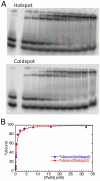Kinetic analysis of the unique error signature of human DNA polymerase ν
- PMID: 22008035
- PMCID: PMC3235957
- DOI: 10.1021/bi201197p
Kinetic analysis of the unique error signature of human DNA polymerase ν
Abstract
The fidelity of DNA synthesis by A-family DNA polymerases ranges from very accurate for bacterial, bacteriophage, and mitochondrial family members to very low for certain eukaryotic homologues. The latter include DNA polymerase ν (Pol ν) which, among all A-family polymerases, is uniquely prone to misincorporating dTTP opposite template G in a highly sequence-dependent manner. Here we present a kinetic analysis of this unusual error specificity, in four different sequence contexts and in comparison to Pol ν's more accurate A-family homologue, the Klenow fragment of Escherichia coli DNA polymerase I. The kinetic data strongly correlate with rates of stable misincorporation during gap-filling DNA synthesis. The lower fidelity of Pol ν compared to that of Klenow fragment can be attributed primarily to a much lower catalytic efficiency for correct dNTP incorporation, whereas both enzymes have similar kinetic parameters for G-dTTP misinsertion. The major contributor to sequence-dependent differences in Pol ν error rates is the reaction rate, k(pol). In the sequence context where fidelity is highest, k(pol) for correct G-dCTP incorporation by Pol ν is ~15-fold faster than k(pol) for G-dTTP misinsertion. However, in sequence contexts where the error rate is higher, k(pol) is the same for both correct and mismatched dNTPs, implying that the transition state does not provide additional discrimination against misinsertion. The results suggest that Pol ν may be fine-tuned to function when high enzyme activity is not a priority and may even be disadvantageous and that the relaxed active-site specificity toward the G-dTTP mispair may be associated with its cellular function(s).
© 2011 American Chemical Society
Figures




Similar articles
-
A unique error signature for human DNA polymerase nu.DNA Repair (Amst). 2007 Feb 4;6(2):213-23. doi: 10.1016/j.dnarep.2006.09.012. Epub 2006 Nov 21. DNA Repair (Amst). 2007. PMID: 17118716 Free PMC article.
-
Steady-state and pre-steady-state kinetic analysis of 8-oxo-7,8-dihydroguanosine triphosphate incorporation and extension by replicative and repair DNA polymerases.Biochemistry. 1998 Sep 22;37(38):13300-12. doi: 10.1021/bi981346d. Biochemistry. 1998. PMID: 9748338
-
Steady-state and pre-steady-state kinetic analysis of dNTP insertion opposite 8-oxo-7,8-dihydroguanine by Escherichia coli polymerases I exo- and II exo-.Biochemistry. 1996 Jul 30;35(30):9840-9. doi: 10.1021/bi960485x. Biochemistry. 1996. PMID: 8703958
-
Structural basis for proficient incorporation of dTTP opposite O6-methylguanine by human DNA polymerase iota.J Biol Chem. 2010 Dec 24;285(52):40666-72. doi: 10.1074/jbc.M110.183665. Epub 2010 Oct 20. J Biol Chem. 2010. PMID: 20961860 Free PMC article.
-
The kinetic and chemical mechanism of high-fidelity DNA polymerases.Biochim Biophys Acta. 2010 May;1804(5):1041-8. doi: 10.1016/j.bbapap.2010.01.006. Epub 2010 Jan 15. Biochim Biophys Acta. 2010. PMID: 20079883 Free PMC article. Review.
Cited by
-
Translesion DNA synthesis and mutagenesis in eukaryotes.Cold Spring Harb Perspect Biol. 2013 Mar 1;5(3):a012708. doi: 10.1101/cshperspect.a012708. Cold Spring Harb Perspect Biol. 2013. PMID: 23457261 Free PMC article. Review.
-
Structures of human DNA polymerases ν and θ expose their end game.Nat Struct Mol Biol. 2015 Apr;22(4):273-5. doi: 10.1038/nsmb.3006. Nat Struct Mol Biol. 2015. PMID: 25837870
-
Conserved overlapping gene arrangement, restricted expression, and biochemical activities of DNA polymerase ν (POLN).J Biol Chem. 2015 Oct 2;290(40):24278-93. doi: 10.1074/jbc.M115.677419. Epub 2015 Aug 12. J Biol Chem. 2015. PMID: 26269593 Free PMC article.
-
Human DNA Polymerase ν Catalyzes Correct and Incorrect DNA Synthesis with High Catalytic Efficiency.J Biol Chem. 2015 Jun 26;290(26):16292-303. doi: 10.1074/jbc.M115.653287. Epub 2015 May 11. J Biol Chem. 2015. PMID: 25963146 Free PMC article.
-
How a homolog of high-fidelity replicases conducts mutagenic DNA synthesis.Nat Struct Mol Biol. 2015 Apr;22(4):298-303. doi: 10.1038/nsmb.2985. Epub 2015 Mar 16. Nat Struct Mol Biol. 2015. PMID: 25775266 Free PMC article.
References
-
- Bebenek K, Kunkel TA. Functions of DNA polymerases. Adv. Protein Chem. 2004;69:137–165. - PubMed
-
- Marini F, Kim N, Schuffert A, Wood RD. POLN, a nuclear PolA family DNA polymerase homologous to the DNA cross-link sensitivity protein Mus308. J. Biol. Chem. 2003;278:32014–32019. - PubMed
-
- Pang M, McConnell M, Fisher PA. The Drosophila mus 308 gene product, implicated in tolerance of DNA interstrand crosslinks, is a nuclear protein found in both ovaries and embryos. DNA Repair (Amst) 2005;4:971–982. - PubMed
Publication types
MeSH terms
Substances
Grants and funding
LinkOut - more resources
Full Text Sources
Research Materials
Miscellaneous

